

November Issue 2001
Works by Bendicht Fivian at Marcel Scheiner Gallery, Hilton Head Island, SC
by Dieter Schwarz
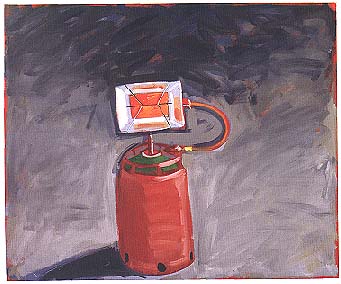 Though the death
of painting has often been foretold, Bendicht Fivian has remained
true to this medium over the years. Indeed, he has constantly
explored the fundamental problems confronting any artist who seeks
to convey visible reality. Fivian's artistic beginnings date back
to the 1960s when, in the vibrant art scene of Berne, Switzerland,
he and his fellow artists, among them Franz Gertsch and Markus
Raetz, discovered international Pop Art and put their own slant
on it. There is not a trace of Pop in Fivian's painting today.
What attracted him at the time and has preoccupied him since is
a form of realistic painting. Though this no longer means looking
to the imagery of the consumer world, it does mean taking a lively
interest in the visual characteristics and effects of phenomena
as they appear to us in everyday life. This everyday life includes
commodities and products in their colourful garb, the rooms and
spaces where they are situated, streets, landscapes, heavenly
bodies and, last but not least, people. Fivian has set himself
the challenge of using painting to tell of this reality. In this
respect, Fivian's approach is in line with that of recent European
and American painters who have persevered in using this medium
to grasp the visible world. Giorgio Morandi springs to mind, as
do David Hockney, Edward Hopper and Fairfield Porter - giving
some indication of the broad range of approaches.
Though the death
of painting has often been foretold, Bendicht Fivian has remained
true to this medium over the years. Indeed, he has constantly
explored the fundamental problems confronting any artist who seeks
to convey visible reality. Fivian's artistic beginnings date back
to the 1960s when, in the vibrant art scene of Berne, Switzerland,
he and his fellow artists, among them Franz Gertsch and Markus
Raetz, discovered international Pop Art and put their own slant
on it. There is not a trace of Pop in Fivian's painting today.
What attracted him at the time and has preoccupied him since is
a form of realistic painting. Though this no longer means looking
to the imagery of the consumer world, it does mean taking a lively
interest in the visual characteristics and effects of phenomena
as they appear to us in everyday life. This everyday life includes
commodities and products in their colourful garb, the rooms and
spaces where they are situated, streets, landscapes, heavenly
bodies and, last but not least, people. Fivian has set himself
the challenge of using painting to tell of this reality. In this
respect, Fivian's approach is in line with that of recent European
and American painters who have persevered in using this medium
to grasp the visible world. Giorgio Morandi springs to mind, as
do David Hockney, Edward Hopper and Fairfield Porter - giving
some indication of the broad range of approaches.
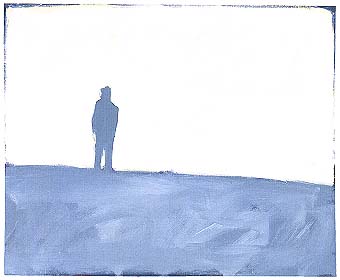 *
* 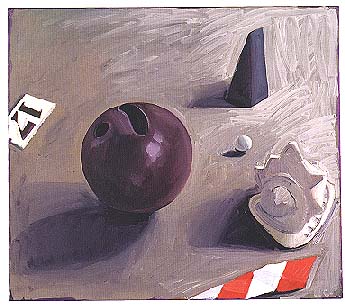
Since moving to Winterhur, Switzerland, in 1975, where he has created his mature oeuvre, Fivian has produced large groups of works devoted to specific motifs. Evidently, the picture plane had to be painted empty first so that Fivian himself could become aware of how to proceed in the future. Clearly outlined cardboard boxes in the bare corner of the room stand out against the pale wall and the dark floor. Out of the seeming monotony the observer begins to discern the subtle tonality; the handling of space and the position of the object is legible by the tilt of a plane, distance and proximity, inside and outside. Gradually, one realizes that what appeared at first to be a rigid object, is made up of nothing but nuances of light and shade that undermine the regularly folded construction, situating it within a mutually dependent area between reflecting its surroundings and affecting them. It is but a short step from there to the facets of the package that transform the surface of this perfectly bound inanimate object into a living entity.
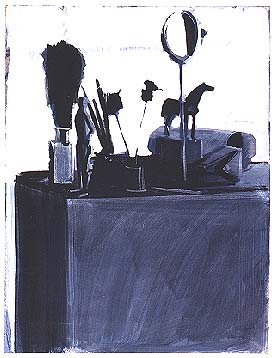 Fivian takes a similar approach to landscape and figures,
whereby it seems to make little difference which of them he paints,
for the overall composition dominates the individual theme. Against
a pale background, angular silhouettes emerge out of a dark ground
with which they seem to be interwoven. Dazzled by the strong light,
the gaze penetrates the inner darkness only slowly to recognize
details there. Thus, the solitary sign that rises on the horizon
becomes a water-tower, and a car and spatial details emerge out
of the shadowy wall. The scene is painted in blue on red, and
it is from this that it draws its density as well as its tendency
to tip towards vivid colour. Fivian proves his consummate mastery
of his chosen inventory by creating a whole range of colour impressions
with a reduced palette. Three or four hues are all he uses to
bring out the full effect of colour in the composition as a whole.
The large formats seem both natural and necessary. They set the
scale so that a plane is not perceived as an inner space between
objects or as an area bounded by the edges of the picture, but
as an autonomous space created through the fluency of the brushwork.
Fivian takes a similar approach to landscape and figures,
whereby it seems to make little difference which of them he paints,
for the overall composition dominates the individual theme. Against
a pale background, angular silhouettes emerge out of a dark ground
with which they seem to be interwoven. Dazzled by the strong light,
the gaze penetrates the inner darkness only slowly to recognize
details there. Thus, the solitary sign that rises on the horizon
becomes a water-tower, and a car and spatial details emerge out
of the shadowy wall. The scene is painted in blue on red, and
it is from this that it draws its density as well as its tendency
to tip towards vivid colour. Fivian proves his consummate mastery
of his chosen inventory by creating a whole range of colour impressions
with a reduced palette. Three or four hues are all he uses to
bring out the full effect of colour in the composition as a whole.
The large formats seem both natural and necessary. They set the
scale so that a plane is not perceived as an inner space between
objects or as an area bounded by the edges of the picture, but
as an autonomous space created through the fluency of the brushwork.
In the densely composed scenes on a box, painted at the same time as the landscapes, there is already a hint of something else that was to take hold more firmly in the course of the 1990s: the notion that objects take over the empty space and unfold within it. The "heater", preceded by the "burner" as though preparing the ground, heralded this development. While the "burner" stands as an isolated body modelled by light in a monochrome room whose rear wall is already articulated by the brush-work, the heater appears not only to concentrate its energy in the heated orange plane that is presented to the spectator and in the tautly arched link, but also conveys its energy to the surrounding area in such a way that the red beneath the grey is illuminated all the more visibly in the shadow. The contrast of green and blue is deliberately used to underpin the reddish grey.
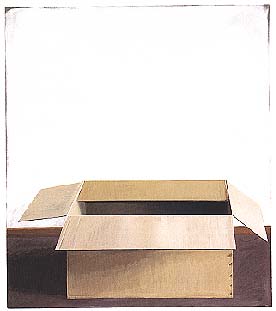 *
* 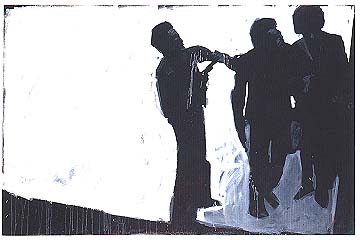
The centrally positioned object with an anthropomorphically evocative form is swept away in the 1990s accumulation of objects scattered at random across the painter's studio. Instead of concentration on the qualities of an individual object that dominates the plane, we find an unordered sprawl. It is not composition Fivian seeks, but the unexpected emergence of contexts and relationships when the objects are found just as they have been left after use. A compositional arrangement would be suspiciously likely to fall into the trap of being overly demonstrative or even lifeless and anodyne. Fivian paints against the rules, accepting the possibility of overlap, condensation and emptiness in applying his choice of perspective, lighting and colour to create a pictorial whole. Yet the world he presents is never whole, for the tension remains, in each picture, between the fragmentary impression and the totality of a world view. This, indeed, is exactly what characterizes realistic painting as a bearer and formulator of tension. Or, in the works of former Basle museum director and art historian Georg Schmidt, its object is "recognizing reality in the widest sense."
Dieter Schwarz is the director of the Kunstmuseum Winterhur, Switzerland.
Editor's Note: Bendicht Fivian Paintings, is on view through Nov. 10 at the Marcel Scheiner Gallery, located on Hilton Head Island, SC. For further information check our SC Commercial Gallery listings, call at 843/785-6060, e-mail at (info@marcelscheinergallery.com) or at (http://www.marcelscheinergallery.com).
Mailing Address: Carolina Arts, P.O. Drawer
427, Bonneau, SC 29431
Telephone, Answering Machine and FAX: 843/825-3408
E-Mail: carolinart@aol.com
Subscriptions are available for $18 a year.
Carolina Arts
is published monthly by Shoestring
Publishing Company, a subsidiary of PSMG, Inc.
Copyright© 2001 by PSMG, Inc., which published Charleston
Arts from July 1987 - Dec. 1994 and South Carolina Arts
from Jan. 1995 - Dec. 1996. It also publishes Carolina Arts
Online, Copyright© 2001 by PSMG, Inc. All rights reserved
by PSMG, Inc. or by the authors of articles. Reproduction or use
without written permission is strictly prohibited. Carolina
Arts is available throughout North & South Carolina.